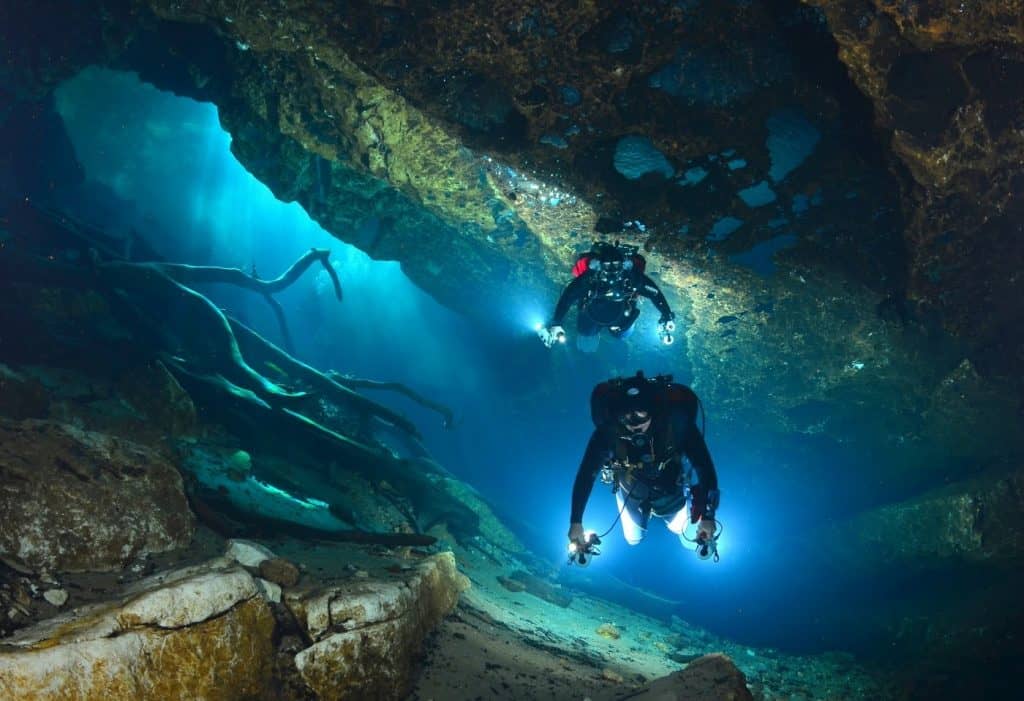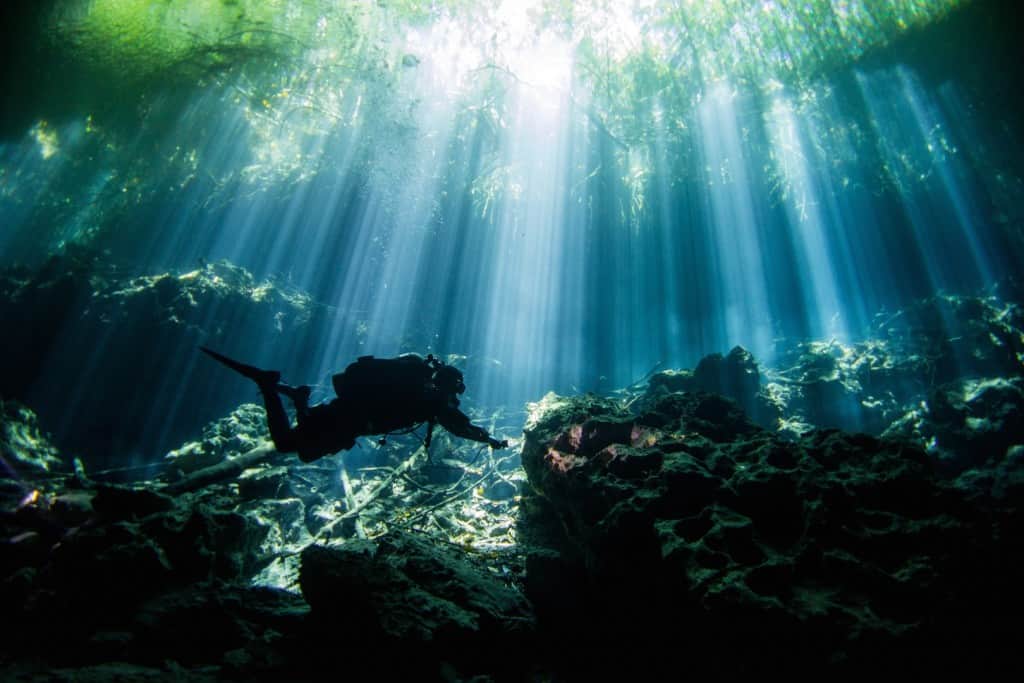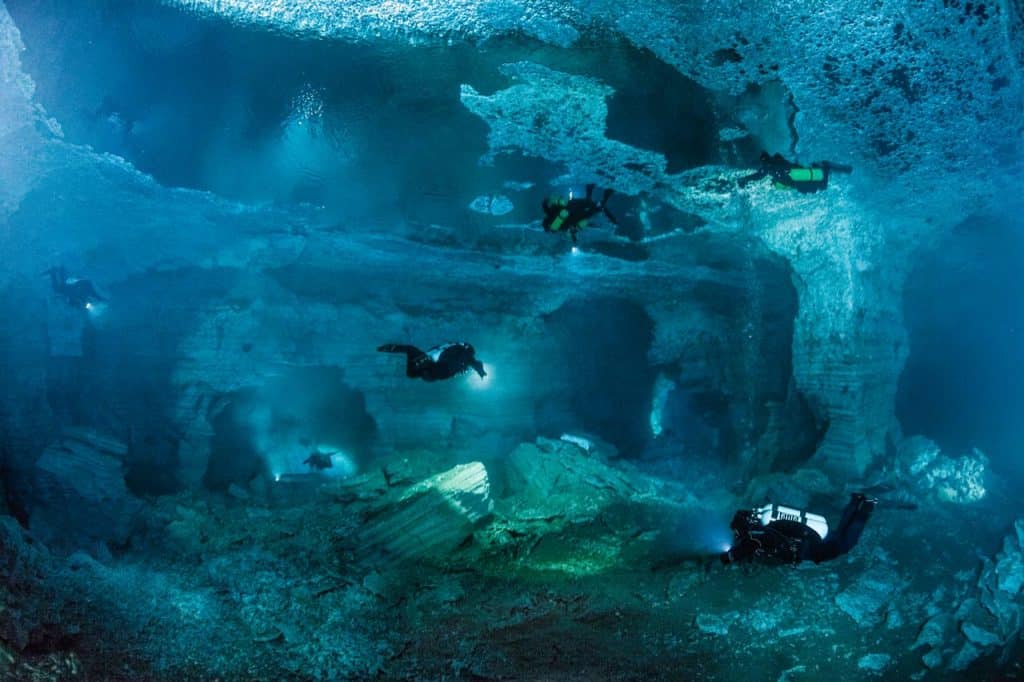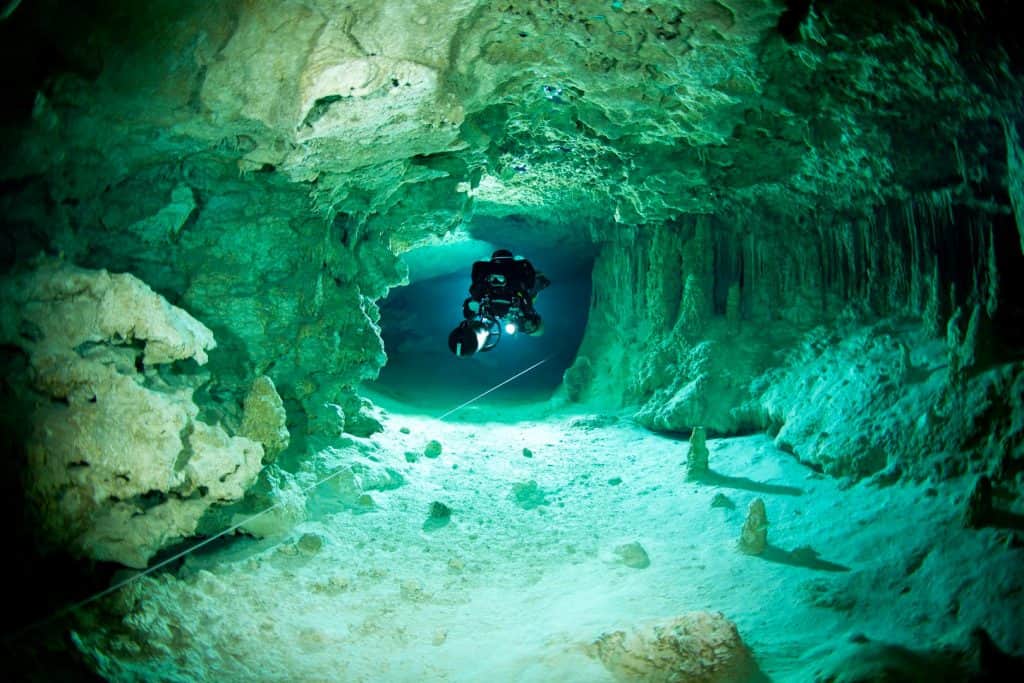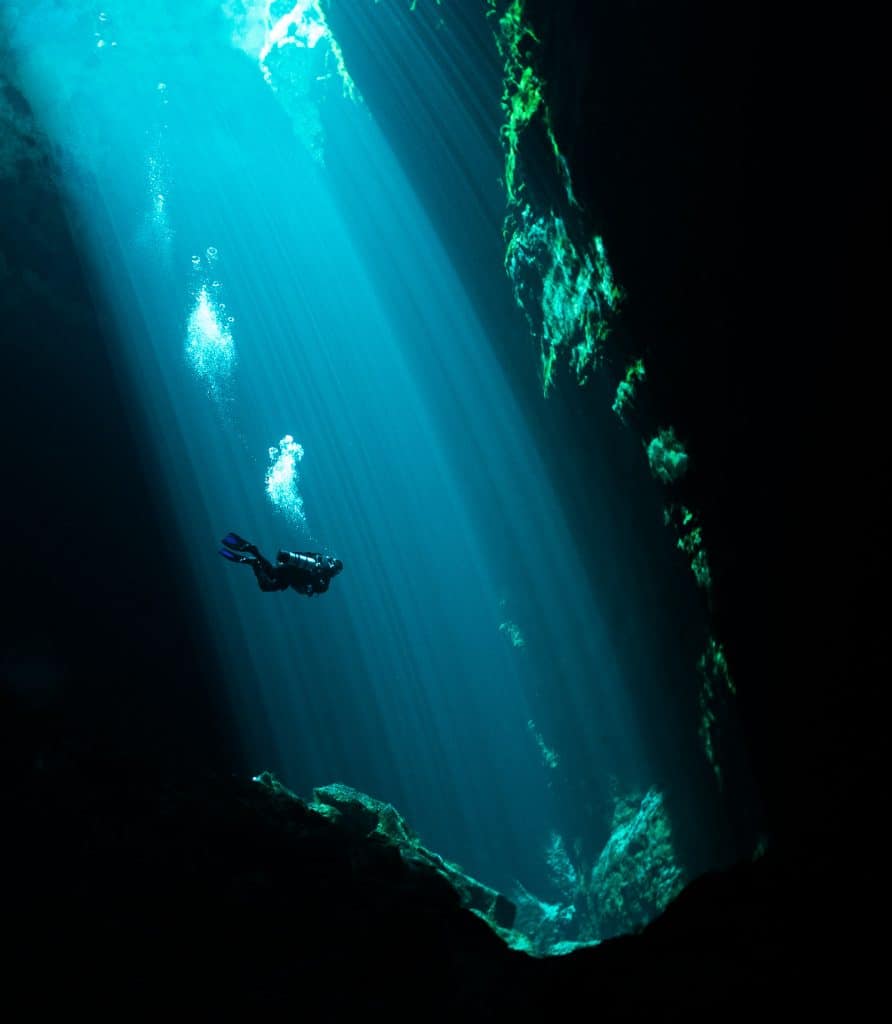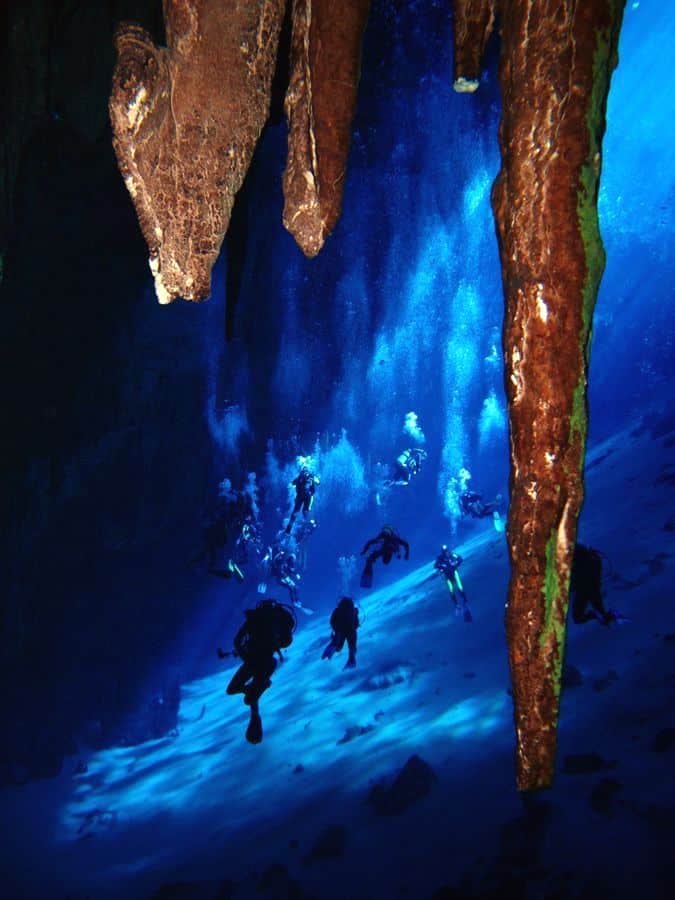In the event that you are planning to go cavern diving in Mexico, you are up for the absolute most surreal underwater encounters in the cenotes by Tulum.
The entire Yucatan peninsula is specked with literally thousands of sinkholes which interface with structure an intricate chain of underwater passages.
Some cenotes resemble lakes, with large openings, others with just cracks for an entrance. You can investigate luxuriously ornate chambers with delicate stalactites and stalagmites, which resembles a travel back in time.
Swimming through the thick layers of hydrogen sulfide is one of the most spooky and deceptive encounters you can get while diving.
And an absolute feature is simply watching the sunbeams puncture the translucent water and magically dance on the base.
We have assembled a list of the most captivating cenotes by Tulum, Playa del Carmen, and Cancun. Each one is one of a kind and you will undoubtedly fall in adoration with these mystical blue openings! Yet, we should initially start with the basics.
What is a cenote and how were cenotes framed?
So what actually are cenotes? To lay it out plainly they are sinkholes loaded up with waters. Yucatan used to be under the surface of the ocean and the limestone we see today developed from fossilized coral and the ocean floor.
At the point when the peninsula started to rise above sea level, underwater streams started to fabricate a cave framework. The caves overflowed which allowed divers today to swim around these ancient formations.
In certain caves and caverns, even ancient Mayan ceramics and bones can be found. The cenotes are basically caves that have collapsed.
The ones that are just half overflowed are also accessible for swimmers and to do other fun activities like zip-lining, kayaking, and swimming.
The top layer of water in the cenotes in Yucatan is freshwater. At the point when you scuba diver further down than 10m to 20m (depending on the cenote), you will reach a purported halocline between the freshwater to the denser saltwater.
The haloclines resemble a mirror inside the water and leave your vision hazy while going through it. Your guide will make sure that each diver gets a chance to play around with the haloclines before everything gets worked up by air pockets and fins.
What is special about cenote/cavern diving?
In the cenotes you will dive in caverns, this means that you will be in an overhead situation. For safety reasons your guide is a completely trained cave diver with special hardware and will never control multiple individuals.
On the off chance that she or he dives with a single tank this means that safety standards are not met and you ought not dive with this guide.
Cavern diving means that you will never be farther than 40m away from the surface, you will always observe natural light and you won’t enter a cave.
Entering a cave means to swim inside a gap where you would have to go around to get out again. Scuba diving in caverns is increasingly similar to overhangs and swim-throughs.
During the dive the gathering is following a line to make sure that nobody gets lost or moves excessively far away from the entrance.
The main extra hardware you ought to bring to a cavern dive is a dive light (or on the off chance that you have a spare one, better bring two). Other than the light you won’t need any special gear.
Who ought to go scuba diving in a cenote?
Basically you are allowed as soon as you have your diving certificate. Nonetheless, it is prescribed to have great buoyancy control to make sure that you don’t to work up the silt from the floor or pulverize the stone formations bumping into them.
The aides will just bring advanced divers to the more delicate and troublesome cenotes. When a stalactite or stalagmite breaks off it is proceeded to can just develop back during the following ice age - simply think about that.
Sand worked up starting from the earliest stage the visibility and as there is without a doubt, next to no current it will stay for quite a while.
You can dive the cenotes in Yucatan all year round. The visibility is always incredible (aside from in the event that somebody works up dregs) and the water temperature is around 26°C - you’ll require a wetsuit!
What will you find in a cavern?
Probably the best thing in the cenotes in Yucatan is the light play from the sun’s rays meeting the crystal clear water.
Different features are limestone caves decorated with stalactites and stalagmites, as well as some Mayan bones and earthenware.
Moreover, it is conceivable to play around with the halocline which seems as though another water surface inside of the water.
You can see them from above and from beneath, while swimming through them they work up and everything will get foggy.
It’s fun once you have your head around what is happening! There is very little untamed life in the caverns. In the ones with larger openings, you may find new water fish, turtles, and in one even there is even a small occupant crocodile!
What is a halocline layer and where can you see one in the cenotes by Tulum?
The top part of the cenotes is loaded with new water from rainfall, while the more profound part, which is associated with the ocean, is loaded up with saltwater. The layer where freshwater meets the denser saltwater is called a halocline.
The demarcation between the two is a haze, which visually reminds of a thermocline (change in temperature).
You can see this wonder distinctly in the cenote Tajma Ha. Haloclines should, notwithstanding, not be mistaken for the famous hydrogen sulfide mists, which can be found in some cenotes.
Cave or cavern diving?
Cavern diving is the exploration of overhead conditions with direct sight of the entrance and no farther than 60 meters (200ft) from the surface. Anything above this distance is viewed as cave diving and requires legitimate training and hardware.
For what reason is it so popular to go cenote diving in Mexico?
Cenote cavern diving is nothing similar to sea and ocean diving. Imagine yourself exploring a cavern or a cave, discovering formations that took a large number of years to create, kilometers of underwater galleries brimming with stalactites and stalagmites.
Presently imagine doing this exploration in your wetsuit and scuba gear. In the event that you haven’t done it, it’s hard to imagine! Cenote diving is an encounter out of this world and can’t be compared to anything else.
Also, Mexico is the nation with the most cenotes on the planet. And the Yucatan peninsula is home to the three longest underwater frameworks on the planet (Dos Ojos 82km, Sac Aktum 172km, and the Ox Bel Ha 270km).
Cenote diving in Mexico is only a magical encounter – submerging in crystal clear new water through a crack in the ground amid the untainted tropical wilderness and entering an alternate era.
With so many cenotes to browse you will want to encounter a touch of everything and plan your dive days according to your interests and diving experience.
We have assembled a list with the most enchanting cenotes by Tulum, Playa del Carmen, and Cancun to assist you with your itinerary.
Diving in the most beautiful cenotes by Tulum
There are all kinds of cenotes for all kinds of divers: recreational, technical, cave, cavern, those passionate about typography and history, beginners and experienced divers. The cenotes have various shapes, section size, cave formations, and natural light penetration.
A portion of the cenotes by Tulum have legitimate untamed water passages like Carwash, Canavera, and Dream Gate.
A large portion of them have gallery frameworks like cenote Dos Ojos whereas not very many are vertical sinkholes like the Pit and Angelita.
Cenote El Pit
This cenote has an amazing cylinder-like structure, about 40 meters (130 ft) in diameter. There is a layer of hydrogen sulfide with dead trees at 30 m (100 ft). The ceiling is beautiful and has a lot of stalactites at about 12 m (40 ft) and an immense draper.
The feature of El Pit is the way the light penetrates the water and the way the sunbeams illuminate the entire cavern.
Cenote Dos Ojos
This shallow cenote is 9m (30 ft) profound. The passage is a massive overhang where the two divers and swimmers can appreciate a luxurious stylistic theme. There are 2 potential courses – the Bat Cave and the Barbie line.
The Barbie Line offers progressively natural light coming through the ground so it is prescribed to do it on a radiant day.
The Bat Cave is a darker track however there is a cave loaded with bats where you can surface. The ceiling is a couple of meters above your head and has a crack letting in some natural light.
Cenote Angelita
Angelita is an entirely round shaped opening. It’s 30-40 meters (100-130 ft) in diameter with a 3 meters (10 ft) thick layer of hydrogen sulfide around 30 meters (100 ft) profound. The cloud circles an underwater island made of dead leaves and trees.
You can’t see anything while at the same time diving through that layer. It resembles being in the thickest haze.
Underneath it’s black as night because of the lack of natural light, which is totally obstructed by the hydrogen sulfide. In the event that you shine your light up, you will see a dark orange-earthy colored red shading.
As you ascend, there is a small caveat 17 meters (60 ft) where you can see a few bones, apparently from flying creatures (or it could also be from KFC, nobody can tell without a doubt).
On the off chance that you dive Angelita on an overcast day or an early in the morning, be prepared to encounter a blueish shading in a calm and amazingly dreadful atmosphere.
Cenote Calavera
Canavera is a small cenote entirely near Tulum. You have to do a 2.5 meters hop to get into the water however no concerns, there is a ladder to leave the hole.
Directly underneath the gap, there is an underwater mountain, the head of which is shallow (just 3m – 10 ft) and secured by green grass and algae.
The way to dive this cenote is called crisscross, meaning you disappear from the section at that point return towards it, diving circularly around the mountain.
This star shape course gives a pleasant contrast between the dark cavern corners and the natural light coming in at the center.
During the dive, you can see a lot of small freshwater fish and for the cave divers there are 4 caves sections around 18m (60 ft)
Cenote Dream Gate
Dream Gate has a great cenote entrance. It is a colossal opening with a lofty staircase and a small island with certain trees and a wooden deck in the middle.
There are 2 courses you can take and typically you can do both on a single dive on the off chance that you are not stopping at each and every stalactite and stalagmite to take a photograph. One is along the downstream and the subsequent one is against the stream.
Cenote Carwash
Aktun-Ha means “cave water” in Mayan and it is the original name of this cenote. It was utilized to be a taxi drivers’ carwash in the no so distant past and that’s the reason it adopted the name “Car Wash”.
It is a flawless small lake near the road, brimming with really underwater lilies with a carpet of grass and algae on the base of the untamed water area, and some dead trees directly at the passage of the cavern.
You dive Aktun-Ha by following a line somewhere inside in the cave and back towards the untamed water area. On the off chance that you are fortunate, you can detect a harmless little caiman around at the surface.
Cenote diving from Playa del Carmen and Cancun
Cenotes are various between Playa del Carmen and Cancun and the place to be in Puerto Morelos, which is located generally at equal distance from the two urban communities. The famous “Ruta de Los cenotes” (course of the cenotes) advantageous exploring before leaving the province.
How about we talk about the amazing cenote Kin Ha and cenote Siete Bocas.
What’s so special about them? Initially, they are not the popular cenotes El Pit and Dos Ojos, meaning they are not packed. On head of being there alone with your guide, the topography and the passages are also atypical making the diving exceptional.
Cenote Kin Ha
This cenote has 3 small sections however just 2 are suitable for scuba divers – with appropriate wooden decks floating at the surface.
The third one is a 3-4 meters diameter gap and probably 5-6 meters above the water. It is a decent hop for the adventurous however not for a diver who is already geared up
Outside the cavern it is extremely hot and radiant, inside it is cool and the 2 artificial lights bring enough luminosity to consider the to be opening as the ceiling is not exceptionally high.
The base is made of silt and there is a 5 meter tall (16 ft) and exceptionally beautiful formation called “The Monster” which can be found on the base at 30 meters (100 ft).
The 3 passages let the sun rays penetrate the water by incredible beams hitting the bottom. In the shallow, some extremely decent stalactites cover the walls and make the last part of the dive a genuine exploration and navigation between them.
Cenote Siete Bocas
“Siete Bocas” means seven mouths. There are 7 entrances however just 2 are suitable for scuba divers. The ceiling of the cenote is penetrated by light beams making the dive special as the “mouths” have various shapes and diameters and light hits the water at various angles.
At around 27 meters (90 ft), a thin layer of hydrogen sulfide can be seen and you can even dive through it. Speedy facts about exploring the Yucatan cenotes
When is the best an ideal opportunity to dive in the Mexican cenotes?
The cool thing about cenote diving in Mexico is that you don’t have to plan your holiday according to seasons.
Diving in the cenotes is conceivable all year round. Be that as it may, going on a radiant day is an unquestionable requirement on the off chance that you want to encounter the magical way the sun beams penetrate the sinkholes!
OCTOBER TO APRIL
While October to April may not be viewed as conditions in the cenotes, there is no bad an ideal opportunity to investigate these subterranean marvels.
October to April is viewed as the best an ideal opportunity to visit Mexico for beach vacations and in this way is the most popular chance to dive in the cenotes.
This is the best season to book your holiday in the event that you might want to combine cenote diving with great outdoors conditions.
Because the winter months comprise high season, you should make sure to book as early as conceivable in request to make sure about the best rate.
Water temperatures in the cenotes remain constant year-round and cool minimally during the winter months. On average, temperatures are approximately 77ºF (24 to 25ºC).
MAY TO SEPTEMBER
The best an ideal opportunity for cenote diving is between May and September. These months bring the best light to the caves and result in better photographs. Note that diving in the cenotes is conceivable year-round.
The main thing to recall during the late spring and early fall months is to watch out for the forecast. These seasons do see the occasional hurricane which may hinder your ability to reach any Mexican destination.
When there isn’t a hurricane, the weather during the mid-year is blistering and sticky with the occasional rain shower.
As an added reward, the mid-year months are low season all through Mexico. At this time, you’ll find the best deals on diving and accommodation.
On the off chance that you appreciate uncrowded dive destinations, travel to Mexico in May and September.
Water temperature in the cenotes
The water in cenotes is hardly ever presented to daylight and in this manner, it is not all that warm being in sinkholes and in overhead situations.
In many cenotes, the water temperature remains constant during the time at around 25°C (77°F). An entire 3 or 5mm wetsuit will be necessary to give enough insulation from the virus.
Visibility in the cenotes
The visibility in the cenotes is incredible and can reach up to 100 meters (330ft). However, rises from your exhalations will definitely make residue fall like tiny snowflakes.
Buoyancy control is important when diving in cenotes as you would prefer not to kick the base and work up the residue with your fins and make the visibility poor as in the event that you were all at sea.
What can you find in the caverns?
The cenotes are home to approximately fifteen types of fish including mollies, catfish and tetras. Almost all of the area’s marine life is small however readily visible because of the clarity of the water and lack of hiding spots. Chara, a sort of algae, is the most widely recognized plant life in the cenote condition.
Because the freshwater to saltwater ratio changes from cenote to cenote, so does the quantity of fish. Some cenotes are seemingly loaded up with small fish while others are practically bereft of marine life.
Substantially more interesting than the marine life in the cenotes are the geological formations. You’ll find stalactites, stalagmites, and tremendous pillars in these ancient sinkholes.
Who can dive in the cenotes?
Each and every individual who is good for scuba diving can dive in cenotes. As there is a vast range of cenotes in the Yucatan peninsula, your instructor or guide will pick one depending on your training and experience.
And on the off chance that you have never dove, no concerns, an open cenote will be picked as it is required in that case to have immediate access to the surface.
Scuba gear for cavern diving
Cavern divers can decide to dive with a single tank (as normal recreational dive setting), side mount (tanks attached on the two sides of the body) or twin tanks (2 tanks attached together located in your back) however the single tank use is the most widely recognized. The main special bit of gear you will require is your dive light.
Different ATTRACTIONS in Mexico
As most tourist-accessible cenotes are located on the Yucatan Peninsula, visitors to the area ought to also avail themselves of the abundant attractions in this part of Mexico.
The most incredible things to find in the locale are the ancient Mayan sanctuaries that speck the landscape. Two of the most famous are Chichen Itza and Tulum.
Aside from the sanctuaries, going on a wilderness trip or two is certain to get your adrenaline pumping!
You’ll also find a lot of watersports from kayaking to parasailing as well as sandy white beaches on which to relax. In the evening, walk around local villages, dine on flavorful Mexican food and shop for local handicrafts.
GETTING THERE
A large portion of the accessible cenotes are located between Playa del Carmen and Tulum. In the event that you are based on the Riviera Maya and wish to investigate independently, renting a car is your best choice.
Otherwise, you should utilize the shared vans that handle the major roads. For the less independent traveler, many swimming and snorkeling visits are operated from tourist focuses, yet divers may find it generally valuable to pursue a visit with a local scuba operator.

